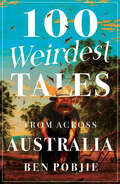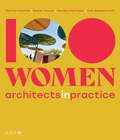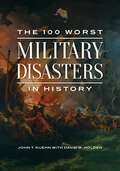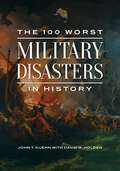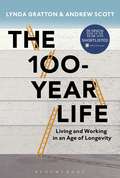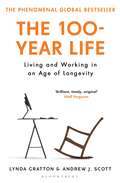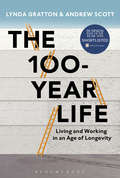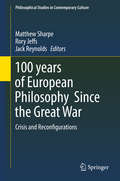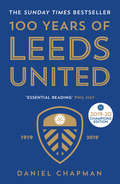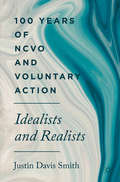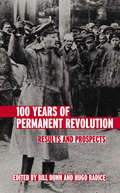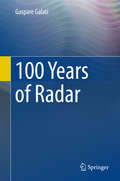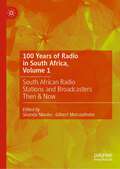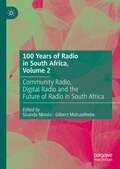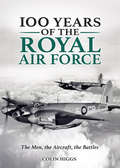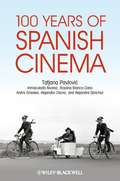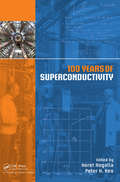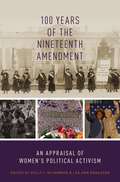- Table View
- List View
100 Weirdest Tales from Across Australia
by Ben PobjieTales of the strange, unnerving and downright bizarre from one of the weirdest places on EarthFish falling out of the sky, joggers relieving themselves on your doorstep, mysterious monsters constantly springing from the shadows, spooky lights and ill-conceived toast spreads: these are just some of the things you can expect on any given day in our surreal southern land.In 100 Weirdest Tales from Across Australia, comedy writer and accredited weirdness expert Ben Pobjie delves deep into Australia's past and present to serve up the weirdest stories of all, which will leave you smacking your gob with one hand while scratching your head with the other.
100 Westerns (Screen Guides)
by Edward BuscombeAddresses the perennial appeal of the Western, exploring its 19th century popular culture, and its relationship to the economic structure of Hollywood. This work considers the defining features of the Western and traces its main cycles, from the epic Westerns of the 1920s and singing cowboys of the 1930s to the Spaghetti Westerns of the 1960s.
100 Westerns (Screen Guides)
by Edward BuscombeAddresses the perennial appeal of the Western, exploring its 19th century popular culture, and its relationship to the economic structure of Hollywood. This work considers the defining features of the Western and traces its main cycles, from the epic Westerns of the 1920s and singing cowboys of the 1930s to the Spaghetti Westerns of the 1960s.
100 Women: Architects in Practice
by Harriet Harriss Naomi House Monika Parrinder Tom RavenscroftAll the architects in this book deserve international recognition. The reality is, though, that few are household names. Over the last decade, awareness of the need for gender balance in architecture has gained traction. Within the profession, women remain underrepresented, underpromoted and underpaid. Failure to acknowledge women’s contribution to the built environment has perpetuated this cycle and impoverished us all. By showcasing 100 exceptional architects – who happen to be women – this book provides a flagship reference to inspire and support everyone working in the profession, no matter how they identify. Global in outlook, the book presents an equitable sample of architects from every continent. We all need heroines as much as heroes. Through illustrated interviews, each woman shares how they are responding to a profound disconnect between architecture and the people and landscape it serves. Their visions, methods and models of leadership are essential to connecting the needs of humans and the planet. In the words of Indigenous Canadian architect Eladia Smoke: ‘Now is a critical time to seek out every opportunity to transmit this knowledge to future generations.’ Featuring: 100 interviews with leading women architects, including: Tatiana Bilbao, Odile Decq, Liz Diller, Julia Gamolina, Dorte Mandrup and Farshid Moussavi. Over 400 photographs and drawings. Geographically balanced selection, with profiles across every continent.
100 Women: Architects in Practice
by Harriet Harriss Naomi House Monika Parrinder Tom RavenscroftAll the architects in this book deserve international recognition. The reality is, though, that few are household names. Over the last decade, awareness of the need for gender balance in architecture has gained traction. Within the profession, women remain underrepresented, underpromoted and underpaid. Failure to acknowledge women’s contribution to the built environment has perpetuated this cycle and impoverished us all. By showcasing 100 exceptional architects – who happen to be women – this book provides a flagship reference to inspire and support everyone working in the profession, no matter how they identify. Global in outlook, the book presents an equitable sample of architects from every continent. We all need heroines as much as heroes. Through illustrated interviews, each woman shares how they are responding to a profound disconnect between architecture and the people and landscape it serves. Their visions, methods and models of leadership are essential to connecting the needs of humans and the planet. In the words of Indigenous Canadian architect Eladia Smoke: ‘Now is a critical time to seek out every opportunity to transmit this knowledge to future generations.’ Featuring: 100 interviews with leading women architects, including: Tatiana Bilbao, Odile Decq, Liz Diller, Julia Gamolina, Dorte Mandrup and Farshid Moussavi. Over 400 photographs and drawings. Geographically balanced selection, with profiles across every continent.
The 100 Worst Military Disasters in History
by John T. KuehnThe 100 Worst Military Disasters in History is a fascinating collection that educators, students, and historians will all find useful in helping them understand the causes and consequences of the most infamous military failures in history.The dynamics of military disaster are equally, if not more, important as understanding how to achieve success on the battlefield. This comprehensive book covers the complete gamut of human history as it tells the compelling stories of the worst military debacles of all time. It covers battles, campaigns, and wars, starting with the ancient Persians and Greeks and finishing with the U.S. conflicts in Afghanistan and Iraq. Not limited to land warfare, however, the book also includes a number of the most disastrous naval engagements and campaigns in world history.The 100 Worst Military Disasters in History opens with a detailed introduction illuminating the role military strategy and politics played in some of the worst battlefield failures throughout history. The entries are augmented with several engaging sidebars related to various military disasters. This eclectic collection includes coverage of many lesser known military disasters such as the Taiping Rebellion, during which 20 times more Chinese died than the number of people killed in the American Civil War.
The 100 Worst Military Disasters in History
by John T. KuehnThe 100 Worst Military Disasters in History is a fascinating collection that educators, students, and historians will all find useful in helping them understand the causes and consequences of the most infamous military failures in history.The dynamics of military disaster are equally, if not more, important as understanding how to achieve success on the battlefield. This comprehensive book covers the complete gamut of human history as it tells the compelling stories of the worst military debacles of all time. It covers battles, campaigns, and wars, starting with the ancient Persians and Greeks and finishing with the U.S. conflicts in Afghanistan and Iraq. Not limited to land warfare, however, the book also includes a number of the most disastrous naval engagements and campaigns in world history.The 100 Worst Military Disasters in History opens with a detailed introduction illuminating the role military strategy and politics played in some of the worst battlefield failures throughout history. The entries are augmented with several engaging sidebars related to various military disasters. This eclectic collection includes coverage of many lesser known military disasters such as the Taiping Rebellion, during which 20 times more Chinese died than the number of people killed in the American Civil War.
The 100-Year Life: Living and Working in an Age of Longevity
by Lynda Gratton Andrew ScottWhat will your 100-year life look like?Does the thought of working for 60 or 70 years fill you with dread? Or can you see the potential for a more stimulating future as a result of having so much extra time? Many of us have been raised on the traditional notion of a three-stage approach to our working lives: education, followed by work and then retirement. But this well-established pathway is already beginning to collapse – life expectancy is rising, final-salary pensions are vanishing, and increasing numbers of people are juggling multiple careers. Whether you are 18, 45 or 60, you will need to do things very differently from previous generations and learn to structure your life in completely new ways.The 100-Year Life is here to help.Drawing on the unique pairing of their experience in psychology and economics, Lynda Gratton and Andrew Scott offer a broad-ranging analysis as well as a raft of solutions, showing how to rethink your finances, your education, your career and your relationships and create a fulfilling 100-year life. · How can you fashion a career and life path that defines you and your values and creates a shifting balance between work and leisure?· What are the most effective ways of boosting your physical and mental health over a longer and more dynamic lifespan?· How can you make the most of your intangible assets – such as family and friends – as you build a productive, longer life?· In a multiple-stage life how can you learn to make the transitions that will be so crucial and experiment with new ways of living, working and learning?Shortlisted for the FT/McKinsey Business Book of the Year Award, The 100-Year Life is a wake-up call that describes what to expect and considers the choices and options that you will face. It is also fundamentally a call to action for individuals, politicians, firms and governments and offers the clearest demonstration that a 100-year life can be a wonderful and inspiring one.
The 100-Year Life: Living and Working in an Age of Longevity
by Lynda Gratton Andrew Scott*A new edition of the international bestseller (a #1 bestseller in Japan), featuring a new preface*Does the thought of working for 60 or 70 years fill you with dread? Or can you see the potential for a more stimulating future as a result of having so much extra time? Many of us have been raised on the traditional notion of a three-stage approach to our working lives: education, followed by work and then retirement. But this well-established pathway is already beginning to collapse – life expectancy is rising, final-salary pensions are vanishing, and increasing numbers of people are juggling multiple careers. Whether you are 18, 45 or 60, you will need to do things very differently from previous generations and learn to structure your life in completely new ways.The 100-Year Life is here to help.Drawing on the unique pairing of their experience in psychology and economics, Lynda Gratton and Andrew Scott offer a broad-ranging analysis as well as a raft of solutions, showing how to rethink your finances, your education, your career and your relationships and create a fulfilling 100-year life. · How can you fashion a career and life path that defines you and your values and creates a shifting balance between work and leisure?· What are the most effective ways of boosting your physical and mental health over a longer and more dynamic lifespan?· How can you make the most of your intangible assets – such as family and friends – as you build a productive, longer life?· In a multiple-stage life how can you learn to make the transitions that will be so crucial and experiment with new ways of living, working and learning?Shortlisted for the FT/McKinsey Business Book of the Year Award and featuring a new preface, The 100-Year Life is a wake-up call that describes what to expect and considers the choices and options that you will face. It is also fundamentally a call to action for individuals, politicians, firms and governments and offers the clearest demonstration that a 100-year life can be a wonderful and inspiring one.
The 100-Year Life: Living and Working in an Age of Longevity
by Andrew Scott Lynda GrattonWhat will your 100-year life look like?Does the thought of working for 60 or 70 years fill you with dread? Or can you see the potential for a more stimulating future as a result of having so much extra time? Many of us have been raised on the traditional notion of a three-stage approach to our working lives: education, followed by work and then retirement. But this well-established pathway is already beginning to collapse – life expectancy is rising, final-salary pensions are vanishing, and increasing numbers of people are juggling multiple careers. Whether you are 18, 45 or 60, you will need to do things very differently from previous generations and learn to structure your life in completely new ways.The 100-Year Life is here to help.Drawing on the unique pairing of their experience in psychology and economics, Lynda Gratton and Andrew Scott offer a broad-ranging analysis as well as a raft of solutions, showing how to rethink your finances, your education, your career and your relationships and create a fulfilling 100-year life. · How can you fashion a career and life path that defines you and your values and creates a shifting balance between work and leisure?· What are the most effective ways of boosting your physical and mental health over a longer and more dynamic lifespan?· How can you make the most of your intangible assets – such as family and friends – as you build a productive, longer life?· In a multiple-stage life how can you learn to make the transitions that will be so crucial and experiment with new ways of living, working and learning?Shortlisted for the FT/McKinsey Business Book of the Year Award, The 100-Year Life is a wake-up call that describes what to expect and considers the choices and options that you will face. It is also fundamentally a call to action for individuals, politicians, firms and governments and offers the clearest demonstration that a 100-year life can be a wonderful and inspiring one.
100 years of European Philosophy Since the Great War: Crisis and Reconfigurations (Philosophical Studies in Contemporary Culture #25)
by Matthew Sharpe Rory Jeffs Jack ReynoldsThis book is a collection of specifically commissioned articles on the key continental European philosophical movements since 1914. It shows how each of these bodies of thought has been shaped by their responses to the horrors set in train by World War I, and considers whether we are yet ‘post-post-war’. The outbreak of World War I in August 1914,set in chain a series of crises and re-configurations, which have continued to shape the world for a century: industrialized slaughter, the end of colonialism and European empires, the rise of the USA, economic crises, fascism, Soviet Marxism, the gulags and the Shoah. Nearly all of the major movements in European thinking (phenomenology, psychoanalysis, Hegelianism, Marxism, political theology, critical theory and neoliberalism) were forged in, or shaped by, attempts to come to terms with the global trauma of the World Wars. This is the first book to describe the development of these movements after World War I, and as such promises to be of interest to philosophers and historians of philosophy around the world.
100 Years of Fundamental Theoretical Physics in the Palm of Your Hand: Integrated Technical Treatment
by E. B. ManoukianThis book aims to integrate, in a pedagogical and technical manner, with detailed derivations, all essential principles of fundamental theoretical physics as developed over the past 100 years. It covers:Quantum physics and Stability Problems in the Quantum World, Minkowski Spacetime PhysicsParticle Classifications and Underlying Symmetries, Symmetry Violations, Quantum Field Theory of Particle Interactions, Higgs Field Physics, Supersymmetry: A Theory with Mathematical BeautySuperstrings, Gravity and Supergravity, General Relativity Predictions, including Frame Dragging, Intricacies of Black Hole Physics, Perturbative and Non-perturbative Quantum GravityIntricacies of Modern Cosmology, including Inflation and Power Spectrum If you are in the process of learning, or are lecturing on, any of the subjects above, then this is your book - irrespective of your specialty.With over-specialization and no time to master all the fields given above, students, and perhaps many physicists, may find it difficult to keep up with all the exciting developments going on, and are even less familiar with their underlying technicalities: e.g. they might have heard that the Universe is 13.8 billion years old, but have no idea on how this number is actually computed.This unique book will be of great value to graduate students, instructors and researchers interested in the intricacies and derivations of the many aspects of modern fundamental theoretical physics. And, although a graduate level book, some chapters may also be suitable for advanced undergraduates in their final year.
100 Years of Happiness: Insights and Findings from the Experts (Psychology, Religion, and Spirituality)
by Nathan S. Carlin Donald Eric CappsThis book sums up 100 of years of research into the study of happiness—from 19th century scientific insights on the subject to the pop psychology perspectives of modern-day America.We all want to be happy, but what does that mean, and how do we get there? These questions may be a popular topic of positive psychology books in recent years, but interest in the subject stretches back over a century. Distinguished authors Nathan Carlin and Donald Capps examine opinions, research studies, and insights about happiness from the 18th century through today. 100 Years of Happiness: Insights and Findings from the Experts is organized into three sections—one that explores insights from philosophers, another part that reviews study results from researchers, and a final section that casts some skepticism on the study of happiness. The authors review what the experts have found, and explore such questions as: Is happiness the goal of life? Is it possible to measure happiness? Is it possible to become happier? What is the difference between unhappiness and depression? If humankind could eliminate unhappiness from the human condition, should we? This fascinating text provides a basis for readers to develop their own conclusions, and to continue humankind's ongoing discourse on the subject.
100 Years of Happiness: Insights and Findings from the Experts (Psychology, Religion, and Spirituality)
by Nathan S. Carlin Donald Eric CappsThis book sums up 100 of years of research into the study of happiness—from 19th century scientific insights on the subject to the pop psychology perspectives of modern-day America.We all want to be happy, but what does that mean, and how do we get there? These questions may be a popular topic of positive psychology books in recent years, but interest in the subject stretches back over a century. Distinguished authors Nathan Carlin and Donald Capps examine opinions, research studies, and insights about happiness from the 18th century through today. 100 Years of Happiness: Insights and Findings from the Experts is organized into three sections—one that explores insights from philosophers, another part that reviews study results from researchers, and a final section that casts some skepticism on the study of happiness. The authors review what the experts have found, and explore such questions as: Is happiness the goal of life? Is it possible to measure happiness? Is it possible to become happier? What is the difference between unhappiness and depression? If humankind could eliminate unhappiness from the human condition, should we? This fascinating text provides a basis for readers to develop their own conclusions, and to continue humankind's ongoing discourse on the subject.
100 Years of Leeds United: 1919-2019
by Daniel ChapmanTHE SUNDAY TIMES BESTSELLER. PUBLISHED IN ASSOCIATION WITH LEEDS UNITED TO COINCIDE WITH THE CLUB'S CENTENARY CELEBRATIONS. 'Every up and down at Leeds United. Essential reading.' - Phil Hay 100 Years of Leeds United tells the story of a one-club city and its unique relationship with its football team. Since its foundation in 1919, Leeds United Football Club has seen more ups and downs than most, rising to global fame through an inimitable and uncompromising style in the 70s, clinching the last Division One title prior to the Premier League's inauguration in 1992, before a spectacular fall from grace at the start of the 21st century. United remains one of the best supported – and most divisive – clubs in football, with supporters’ clubs dotted across the globe. In 100 Years of Leeds United, Chapman delves deep into the archives to discover the lesser-known episodes, providing fresh context to the folkloric tales that have shaped the club we know today, painting the definitive picture of the West Yorkshire giants.
100 Years of NCVO and Voluntary Action: Idealists and Realists
by Justin Davis SmithThis book explores the rich history of voluntary action in the United Kingdom over the past 100 years, through the lens of the National Council for Voluntary Organisations (NCVO), which celebrates its centenary in 2019. From its establishment at the end of the First World War, through the creation of the Welfare State in the middle of the twentieth century, to New Labour and the Big Society at the beginning of this century, NCVO has been at the forefront of major developments within society and the voluntary movement. The book examines its many successes, including its role in establishing high-profile charities such as Age Concern, the Youth Hostels Association, and National Association of Citizens’ Advice Bureaux. It charts the development of closer relations with the state, resulting in growing awareness of the value of voluntary action, increased funding, and beneficial changes to public policy, tax and charity law. But it also explores the criticisms NCVO has faced, in particular that by pursuing a partnership agenda and championing professionalisation, it has contributed to an erosion of the movement’s independence and distinctiveness.
100 Years of Permanent Revolution: Results and Prospects
by Bill Dunn Hugo RadiceOne hundred years on from their first appearance in Leon Trotsky's Results and Prospects, this is a critical re-evaluation of two key Marxist theories: uneven and combined development, and permanent revolution. It brings together a formidable array of Marxist intellectuals from across the world including Daniel Bensaid, Michael Löwy, Hillel Ticktin and Patrick Bond.*BR**BR*Marx saw societies progressing through distinct historical stages – feudal, bourgeois and communist. Trotsky advanced this model by considering how countries at different stages of development influence each other. Developed countries colonise less developed countries and exploit their people and resources. Elsewhere, even as many were kept in poverty, the influence of foreign capital and state-led industrialisation produced novel economic forms and prospects for political alliances and change. *BR**BR*The contributors show how, 100 years on from its original publication, Trotsky's theories are hugely useful for understanding today's globalised economy, dominated by US imperialism.
100 Years of Radar
by Gaspare GalatiThis book offers fascinating insights into the key technical and scientific developments in the history of radar, from the first patent, taken out by Hülsmeyer in 1904, through to the present day. Landmark events are highlighted and fascinating insights provided into the exceptional people who made possible the progress in the field, including the scientists and technologists who worked independently and under strict secrecy in various countries across the world in the 1930s and the big businessmen who played an important role after World War II. The book encourages multiple levels of reading. The author is a leading radar researcher who is ideally placed to offer a technical/scientific perspective as well as a historical one. He has taken care to structure and write the book in such a way as to appeal to both non-specialists and experts. The book is not sponsored by any company or body, either formally or informally, and is therefore entirely unbiased. The text is enriched by approximately three hundred images, most of which are original and have been accessed by detailed searches in the archives.
100 Years of Radio in South Africa, Volume 1: South African Radio Stations and Broadcasters Then & Now
by Sisanda Nkoala Gilbert MotsaathebeThe book brings together media scholars and practitioners to deliberate on the role and influence of radio broadcasting in South Africa over the past 100 years. The publication will add to the existing body of knowledge on radio in this context by being among one of the few to consider radio broadcasting in South Africa. Essentially, the book will make a distinct contribution by providing the following: a historical account of the development of the sector, an in-depth look at some of the key people and institutions that have shaped the sector, and a critique of the medium’s role in community-building and culture making among others. While the book will provide relevant theoretical frameworks, it also aims to include the voices of media practitioners who can reflect on the importance of this medium from a more realistic perspective. Volume 1 focuses on South African radio stations and broadcasters in the past and present.
100 Years of Radio in South Africa, Volume 2: Community Radio, Digital Radio and the Future of Radio in South Africa
by Sisanda Nkoala Gilbert MotsaathebeThe book brings together media scholars and practitioners to deliberate on the role and influence of radio broadcasting in South Africa over the past 100 years. The publication will add to the existing body of knowledge on radio in this context by being among one of the few to consider radio broadcasting in South Africa. Essentially, the book will make a distinct contribution focusing on a critique of the medium’s role in community-building and culture making among others. While the book will provide relevant theoretical frameworks, it also aims to include the voices of media practitioners who can reflect on the importance of this medium from a more realistic perspective. Volume 2 focuses on the impact of digitization on radio in South Africa, and considers the future of radio in South Africa.
100 Years of The Royal Air Force: The Men, The Aircraft, The Battles
by Colin HiggsThe Royal Air Force has been central to the evolution of air power for 100 years. It is also the oldest independent air force in the world with origins that take it back to the earliest days of flight. Formed in 1918 while the outcome of the First World War was still in doubt the Royal Air Force has played a vital part in the defence of Britain and her allies for a century. 100 Years of the Royal Air Force is a fast-paced and authoritative account of the history, the aeroplanes, the technology and the people who have flown and fought for the service and it is illustrated with more than 150 great images from a wide variety of sources. It tells of the early days when the RAF was formed from the merger of the RFC and the RNAS; the fight to stay independent in the inter-war years; the vitally important battles fought during the Second World War - the Battle of Britain, the bomber campaign, Coastal Command s fight to maintain Britain s sealanes and the tireless work of Transport Command. The coming of jet aircraft revolutionised the work of the RAF as did the advent of flight refuelling, the missile and many other key inventions. The modern Royal Air Force, now smaller and constrained by budgets, has maintained its reputation as an agile, adaptable and capable force.
100 Years of Spanish Cinema
by Tatjana Pavlović Inmaculada Alvarez Rosana Blanco-Cano Anitra Grisales Alejandra Osorio Alejandra Sánchez100 Years of Spanish Cinema provides an in-depth look at the most important movements, films, and directors of twentieth-century Spain from the silent era to the present day. A glossary of film terms provides definitions of essential technical, aesthetic, and historical terms Features a visual portfolio illustrating key points of many of the films analyzed Includes a clear, concise timeline to help students quickly place films and genres in Spain’s political, economical, and historical contexts Discusses over 20 films including Amor Que Mata, Un Chien Andalou, Viridana, El Verdugo, El Crimen de Cuenca, and Pepi, Luci, Born
100 Years of Superconductivity
by Horst Rogalla Peter H. KesEven a hundred years after its discovery, superconductivity continues to bring us new surprises, from superconducting magnets used in MRI to quantum detectors in electronics. 100 Years of Superconductivity presents a comprehensive collection of topics on nearly all the subdisciplines of superconductivity. Tracing the historical developments in supe
100 YEARS OF THE 19TH AMENDMENT C: An Appraisal of Women's Political Activism
by Holly J. McCammon and Lee Ann BanaszakThe year 2020 will mark the 100th anniversary of the Nineteenth Amendment giving many women in the United States the right to vote. The struggle for suffrage lasted over six decades and involved more than a million women; yet, even at the moment of the amendment's enactment, women's activists disagreed heartily over how much had been achieved, whether it was necessary for women to continue organizing for political rights, and what those political rights would bring. Looking forward to the 100-year anniversary of the passage of the Nineteenth Amendment, this collection of original essays takes a long view of the past century of women's political engagement to gauge how much women have achieved in the political arena. The volume looks back at the decades since women won the right to vote to analyze the changes, developments, and even continuities in women's roles in the broad political sphere. Ultimately, the book asks two important questions about the last 100 years of women's suffrage: 1) How did the Nineteenth Amendment alter the American political system? and 2) How has women's engagement in politics changed over the last 100 years? As the chapters reveal, while women have made substantial strides in the political realm--voting at higher rates than men and gaining prominent leadership roles--barriers to gender equality remain. Women continue to be underrepresented in political office and to confront gender bias in a myriad of political settings. The contributors also remind us of the important understanding to be gained from an intersectional perspective to women's political engagement. In particular, several chapters discuss the failure of the Nineteenth Amendment to provide full political rights and representation to African American, Latina, and poorer women. The work also considers women's extra-institutional activism in a wide variety of settings, including in the feminist, civil rights, environmental, and far-right movements. As the volume traces women's forceful presence and limitations in politics over the past century, it also helps us look forward to consider the next 100 years: what additional victories might be won and what new defeats will need women's response?
100 Years of the Infanticide Act: Legacy, Impact and Future Directions
by Karen Brennan and Emma MilneThis book provides the first comprehensive and detailed analysis of the Infanticide Act and its impact in England and Wales and around the world.It is 100 years since an Infanticide Act was first passed in England and Wales. The statute, re-enacted in 1938, allows for leniency to be given to women who kill their infants within the first year of life. This legislation is unique and controversial: it creates a specific offence and defence that is available only to women who kill their biological infants. Men and other carers are not able to avail of the special mitigation provided by the Act, nor are women who kill older children.The collection brings together leading experts in the field to offer important insights into the history of the law, how it works today, the impact and legacy of the statute and potential futures of infanticide laws around the world.Contributors consider the Act in practice in England and Wales, the ways it has been portrayed in the British media and justifications for and criticisms of the provision of special treatment for women who kill their infants within a year of birth.It also looks at the criminal justice responses to infanticide in other jurisdictions, such as Australia, Ireland, Sweden and the United States of America.
